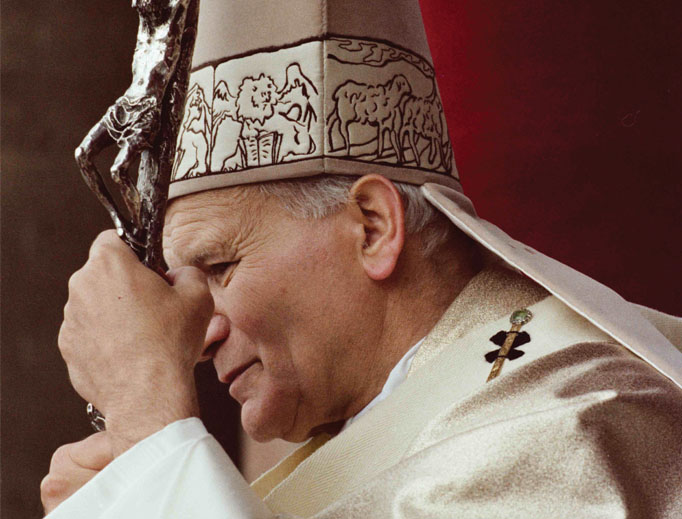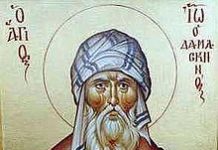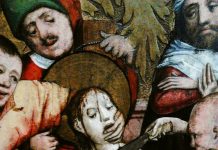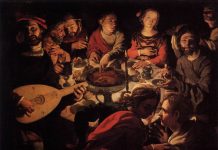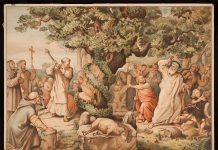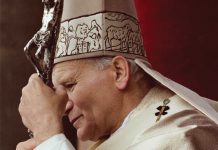JOHN PAUL II
SLAVORUM APOSTOLI
I. INTRODUCTION
1. THE APOSTLES OF THE SLAVS, Saints Cyril and Methodius, are remembered by the Church together with the great work of evangelization which they carried out. Indeed it can be said that their memory is particularly vivid and relevant to our day.
Considering the grateful veneration enjoyed for centuries by the holy Brothers from Salonika (the ancient Thessalonica), especially among the Slav nations, and mindful of their incalculable contribution to the work of proclaiming the Gospel among those peoples; mindful too of the cause of reconciliation, friendly coexistence, human development and respect for the intrinsic dignity of every nation, by my Apostolic Letter Egregiae Virtutis1 of 31 December 1980 I proclaimed Saints Cyril and Methodius Co-Patrons of Europe. In this way I followed the path already traced out by my Predecessors, and notably by Leo XIII, who over a hundred years ago, on 30 September 1880, extended the cult of the two Saints to the whole Church, with the Encyclical Epistle Grande Munus,2 and by Paul VI, who, with the Apostolic Letter Pacis Nuntius3 of 24 October 1964, proclaimed Saint Benedict Patron of Europe.
2. The purpose of the document of five years ago was to remind people of these solemn acts of the Church and to call the attention of Christians and of all people of good will who have at heart the welfare, harmony and unity of Europe to the ever-living relevance of the eminent figures of Benedict, Cyril and Methodius, as concrete models and spiritual aids for the Christians of today, and especially for the nations of the continent of Europe, which, especially through the prayers and work of these saints, have long been consciously and originally rooted in the Church and in Christian tradition.
The publication of my Apostolic Letter in 1980, which was dictated by the firm hope of a gradual overcoming in Europe and the world of everything that divides the Churches, nations and peoples, was linked to three circumstances that were the subject of my prayer and reflection. The first was the eleventh centenary of the Pontifical Letter Industriae Tuae,4 whereby Pope John VIII in the year 880 approved the use of the Old Slavonic language in the liturgy translated by the two holy Brothers. The second circumstance was the first centenary of the above-mentioned Encyclical Epistle Grande Munus. The third was the beginning, precisely in 1980, of the happy and promising theological dialogue between the Catholic Church and the Orthodox Churches on the Island of Patmos.
3. In the present document I wish to make particular reference to the Epistle Grande Munus, by which Pope Leo III intended to remind the Church and the world of the apostolic merits of both the Brothers-not only of Methodius, who, according to tradition, ended his days at Velehrad in Greater Moravia in the year 885, but also of Cyril, whom death separated from his brother in 869, when he was in Rome, the city which received and which still preserves his relics with profound veneration in the Basilica of Saint Clement.
Recalling the holy lives and apostolic merits of the two Brothers from Salonika, Pope Leo XIII fixed their annual liturgical feast on 7 July. After the Second Vatican Council, as a result of the liturgical reform, the feast was transferred to 14 February, which from the historical point of view is the date of the heavenly birthday of Saint Cyril.5 At a distance of over a hundred years from Pope Leo’s Epistle, the new circumstances in which it so happens that there falls the eleventh centenary of the death of Saint Methodius encourage us to give renewed expression to the Church’s memory of this important anniversary. And a particular obligation to do so is felt by the first Pope called to the See of Peter from Poland, and thus from the midst of the Slav nations.
The events of the last hundred years and especially of the last decades have helped to revive in the Church not only the religious memory of the two holy Brothers but also a historical and cultural interest in them. Their special charisms have become still better understood in the light of the situations and experiences of our own times. A contribution to this has been made by many events which belong, as true signs of the times, to the history of the twentieth century; the first of these is that great event which took place in the life of the Church: the Second Vatican Council. In the light of the magisterium and pastoral orientation of that Councils we can look in a new way-a more mature and profound way-at these two holy figures, now separated from us by eleven centuries. And we can read in their lives and apostolic activity the elements that the wisdom of divine Providence placed in them, so that they might be revealed with fresh fullness in our own age and might bear new fruits.
II. BIOGRAPHICAL SKETCH
4. Following the example offered by the Epistle Grande Munus, I wish to recall the life of Saint Methodius, without however thereby ignoring the life-so closely liked to it-of his brother Saint Cyril. This I will do in general terms, leaving to historical research the detailed discussion of individual points.
The city which saw the birth of the two holy Brothers is the modern Salonika, which in the ninth century was an important centre of commercial and political life in the Byzantine Empire, and occupied a notable position in the intellectual and social life of that part of the Balkans. Being situated on the frontier of the Slav territories, it also certainly had a Slav name: Solun.
Methodius was the elder brother and his baptismal name was probably Michael. He was born between 815 and 820. His younger brother Constantine, who came to be better known by his religious name Cyril, was born in 827 or 828. Their father was a senior official of the imperial administration. The family’s social position made possible for the two Brothers a similar career, which in fact Methodius did take up, reaching the rank of Archon or Prefect in one of the frontier Provinces where many Slavs lived. However, towards the year 840 he interrupted his career and retired to one of the monasteries at the foot of Mount Olympus in Bithynia, then known as the Holy Mountain.
His brother Cyril studied with great success in Byzantium, where he received Holy Orders, after having resolutely refused a brilliant political future. By reason of his exceptional intellectual and religious talents and knowledge, there were entrusted to him while he has still a young man delicate ecclesiastical appointments, such as that of Librarian of the Archive attached to the great church of Holy Wisdom in Constantinople, and, simultaneously, the prestigious position of Secretary to the Patriarch of that city. However, he very soon made it known that he wished to be relieved of these posts, in order to be able to devote himself to study and the contemplative life, far from the pursuit of ambition. Thus he retired secretly to a monastery on the Black Sea coast. He was discovered six months later, and was persuaded to accept the task of teaching philosophy in the School of higher learning in Constantinople, where by reason of the excellence of his knowledge he gained the epithet of The Philosopher by which he is still known. Later on he was sent by the emperor and the Patriarch on a mission to the Saracens. On the completion of this task he retired from public life in order to join his elder brother Methodius and share with him the monastic life. But once again, together with Methodius, he was included in a Byzantine delegation sent to the Khazars, acting as a religious and cultural expert. While staying in the Crimea at Kherson, they identified what they believed to be the church in which had been buried Saint Clement, Pope of Rome and martyr, who had been exiled to that distant region. They recovered his relics and took them with them.6 These relics later accompanied the two holy Brothers on their missionary journey to the West, until they were able to bring them solemnly to Rome and present them to Pope Hadrian II.
5. The event which was to determine the whole of the rest of their lives was the request made by Prince Rastislav of Greater Moravia to the Emperor Michael III, to send to his peoples “a Bishop and teacher … able to explain to them the true Christian faith in their own language”.7
Those chosen were Saints Cyril and Methodius, who readily accepted, set out and, probably by the year 863, reached Greater Moravia-a State then including various Slav peoples of Central Europe, at the crossroads of the mutual influences between East and West. They undertook among these peoples that mission to which both of them devoted the rest of their lives, spent amidst journeys, privations, sufferings, hostility and persecution, which for Methodius included even a period of cruel imprisonment. All of this they bore with strong faith and indomitable hope in God. They had in fact prepared well for the task entrusted to them: they took with them the texts of the Sacred Scriptures needed for celebrating the Sacred Liturgy, which they had prepared and translated into the Old Slavonic language and written in a new alphabet, devised by Constantine the Philosopher and perfectly adapted to the sounds of that language. The missionary activity of the two Brothers was accompanied by notable success, but also by the understandable difficulties which the preceding initial Christianization, carried out by the neighboring Latin Churches, placed in the way of the new missionaries.
About three years later, while travelling to Rome, they stopped in Pannonia where the Slav Prince Kocel, who had fled from the important civil and religious center of Nitra, gave them a hospitable reception. From here, after some months, they set out again for Rome together with their followers, for whom they desired to obtain Holy Orders. Their route passed through Venice, where the innovating elements of the mission they were carrying out were subjected to a public discussion. In Rome Pope Hadrian II, who had in the meantime succeeded Nicholas I, received them very cordially. He approved the Slavonic liturgical books, which he ordered to be solemnly placed on the altar in the Church of Saint Mary ad Praesepe, today known as Saint Mary Major, and recommended that their followers be ordained priests. This phase of their efforts concluded in a most favorable manner. Methodius however had to carry out the next stages by himself, because his younger brother, now gravely ill, scarcely had time to take religious vows and put on the monastic habit before he died shortly afterwards, on 14 February 869 in Rome.
6. Saint Methodius remained faithful to the words which Cyril had said to him on his deathbed: “Behold, my brother, we have shared the same destiny, ploughing the same furrow; I now fall in the field at the end of my day. I know that you greatly love your Mountain; but do not for the sake of the Mountain give up your work of teaching. For where better can you and salvation?”8
Consecrated Archbishop for the territory of the ancient Diocese of Pannonia, and named Papal Legate “ad gentes” (for the Slav peoples), he assumed the ecclesiastical title of the re-established Episcopal See of Sirmium. However, Methodius’ apostolic activity was cut short as the result of political and religious complications which culminated in his imprisonment for two years, on the charge of having invaded the episcopal jurisdiction of another. He was set free only on the personal intervention of Pope John VIII. The new sovereign of Greater Moravia, Prince Svatopluk, also subsequently showed hostility to the work of Methodius. He opposed the Slavonic liturgy and spread doubts in Rome about the new Archbishop’s orthodoxy. In the year 880 Methodius was called ad limina Apostolorum, to present once more the whole question personally to John VIII. In Rome, absolved of all the accusations, he obtained from the Pope the publication of the Bull Industriae Tuae,9 which, at least in substance, restored the prerogatives granted to the liturgy in Slavonic by Pope John’s predecessor Hadrian II.
When in 881 or 882 Methodius went to Constantinople, he received a similar recognition of perfect legitimacy and orthodoxy also from the Byzantine Emperor and the Patriarch Photius, who at that time was in full communion with Rome. He devoted the last years of his life principally to making further translations of the Sacred Scriptures, the liturgical books, the works of the Fathers of the Church and also the collection of ecclesiastical and Byzantine civil laws called the Nomocanon. Concerned for the survival of the work which he had begun, he named as his successor his disciple Gorazd. He died on 6 April 885 in the service of the Church established among the Slav peoples.
7. His far-seeing work, his profound and orthodox doctrine, his balance, loyalty, apostolic zeal and intrepid magnanimity gained Methodius the recognition and trust of Roman Pontiffs, of Patriarchs of Constantinople, of Byzantine Emperors and of various Princes of the young Slav peoples. Thus he became the guide and legitimate Pastor of the Church which in that age became established in the midst of those nations. He is unanimously venerated, together with his brother Constantine, as the preacher of the Gospel and teacher “from God and the holy Apostle Peter”,10 and as the foundation of full unity between the Churches of recent foundation and the more ancient ones.
For this reason, “men and women, humble and powerful, rich and poor, free men and slaves, widows and orphans, foreigners and local people, the healthy and the sick”11 made up the throng that amid tears and songs accompanied to his burial place the good Teacher and Pastor who had become “all things to all men, that I might by all means save some”.12
To tell the truth, after the death of Methodius the work of the holy Brothers suffered a grave crisis, and persecution of their followers grew so severe that the latter were forced to abandon their missionary field. Nonetheless, their sowing of the Gospel seed did not cease to bear fruit, and their pastoral attitude of concern to bring the revealed truth to new peoples while respecting their cultural originality remains a living model for the Church and for the missionaries of all ages.
(To continue reading, please see here).

